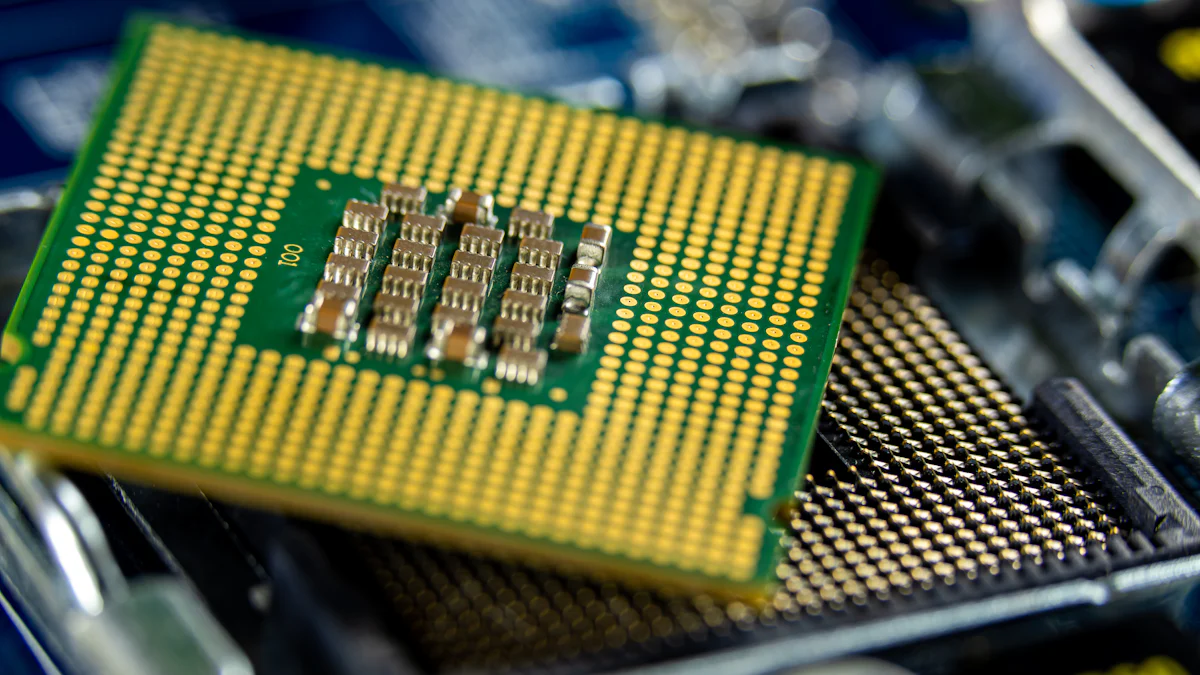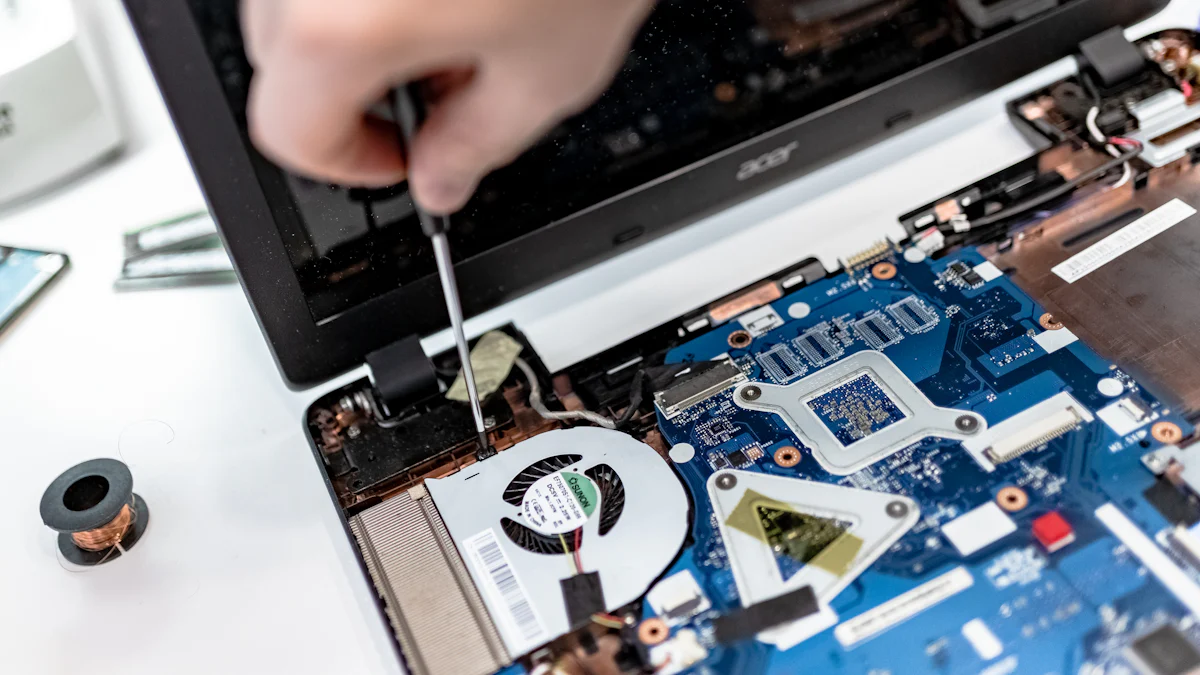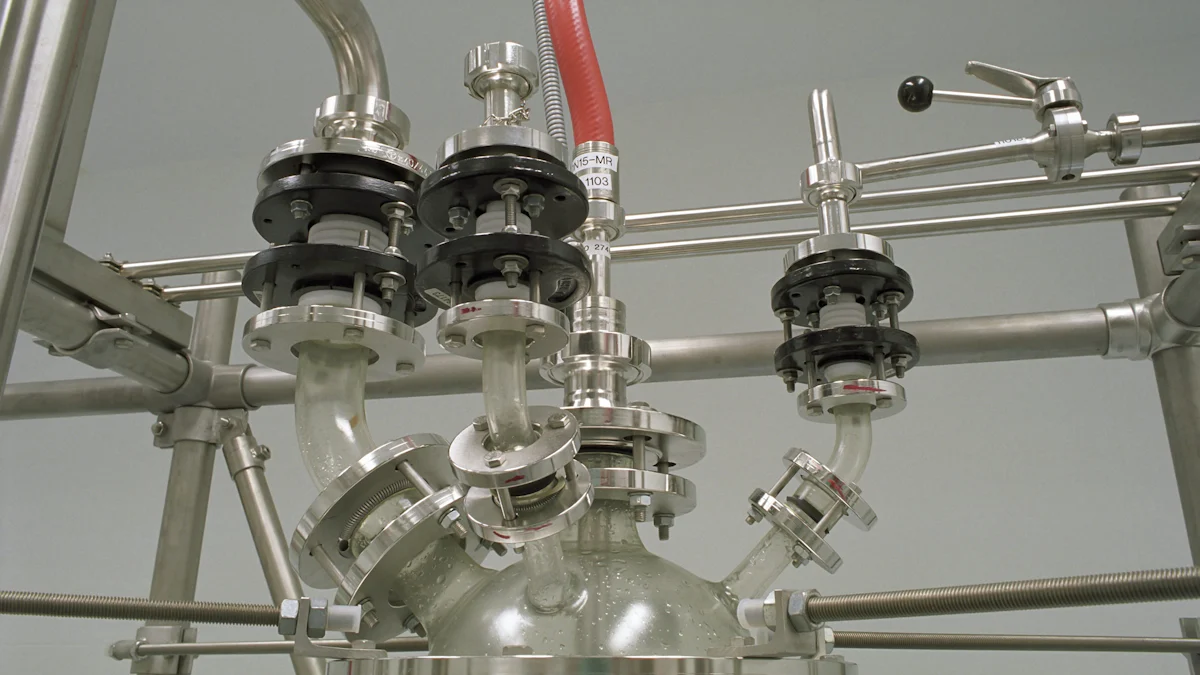
Aixtron reactor components play a pivotal role in the Metal-Organic Chemical Vapor Deposition (MOCVD) process, which drives the growth of advanced semiconductor materials. The vaporizer, reactor chamber, and exhaust system form the backbone of this technology. Each component ensures precision and efficiency, enabling the production of high-quality epitaxial layers. For instance, Aixtron's Planetary Reactor® platform is renowned for its unmatched uniformity in thickness and wavelength control, making it indispensable for applications like VCSELs and 3D sensors. Understanding these components simplifies the complexities of semiconductor manufacturing.
Key Takeaways
- Understand the three main components of Aixtron reactors: the vaporizer, reactor chamber, and exhaust system, as they are crucial for efficient semiconductor manufacturing.
- The vaporizer optimizes the conversion of liquid precursors to gas, ensuring minimal waste and high-quality thin films essential for advanced applications like VCSELs.
- The reactor chamber maintains optimal conditions for material growth, directly influencing the uniformity and performance of semiconductor devices.
- The exhaust system is vital for maintaining a clean environment by removing harmful byproducts, which enhances reactor efficiency and safety.
- Familiarizing yourself with these components can simplify the complexities of semiconductor manufacturing and improve production outcomes.
- Aixtron's innovative technologies, such as the Close Coupled Showerhead® and TriJet® vaporizer, exemplify advancements that drive efficiency and quality in the MOCVD process.
- By leveraging the strengths of each reactor component, manufacturers can achieve higher yields and lower costs, reinforcing the importance of MOCVD technology in modern industries.
The Vaporizer: Converting Liquid to Gas

What is the Vaporizer?
The vaporizer serves as a critical component in the Aixtron reactor system. It transforms liquid precursors into gaseous form, a process essential for the Metal-Organic Chemical Vapor Deposition (MOCVD) method. This conversion ensures that the precursors are in the optimal state for deposition within the reactor chamber. By utilizing advanced technologies like the proprietary TriJet® vaporizer, Aixtron achieves precise control over the vaporization process. This innovation allows for the handling of low vapor pressure metal-organic precursors with remarkable efficiency.
A consistent supply of process gases is vital for maintaining the stability of the MOCVD process. The vaporizer ensures this consistency by regulating the flow and composition of the gases. This regulation minimizes fluctuations, which could otherwise compromise the uniformity of the epitaxial layers. The integration of technologies such as the Close Coupled Showerhead® further enhances the vaporizer's ability to deliver multi-component materials with excellent composition control.
Why the Vaporizer Matters
The vaporizer significantly impacts the efficiency of the deposition process. By optimizing the transformation of liquid precursors, it reduces material waste and maximizes the utilization of expensive chemicals. This efficiency directly translates to cost savings and higher production yields. For example, the Aixtron AIX 2800G4 platform demonstrates exceptional efficiency in managing precursor materials, ensuring minimal loss during the MOCVD process.
The quality of the semiconductor material depends heavily on the vaporizer's performance. A well-functioning vaporizer ensures that the gaseous precursors are delivered in a stable and uniform manner, which is crucial for achieving high-quality thin films. These films are essential for applications like VCSELs and 3D sensors, where precision and reliability are paramount. The vaporizer's role in maintaining this quality underscores its importance in the overall Aixtron reactor component ecosystem.
The Reactor Chamber: The Core of the Process

What is the Reactor Chamber?
The reactor chamber serves as the central hub where critical chemical reactions occur during the Metal-Organic Chemical Vapor Deposition (MOCVD) process. This component provides a controlled environment, ensuring that the precursors interact precisely to form high-quality epitaxial layers. By maintaining optimal temperature, pressure, and gas flow, the reactor chamber creates the ideal conditions for material growth.
Aixtron's advanced reactor designs, such as the Close Coupled Showerhead® (CCS) technology, exemplify innovation in this area. This system ensures uniform distribution of gases across the wafer surface, which is essential for achieving consistent deposition. For instance, the successful installation of the CCS 2D MOCVD reactor at imec in Belgium highlights its capability to support large-scale epitaxial deposition on 200/300 mm wafers. Such advancements underline the reactor chamber's pivotal role in modern semiconductor manufacturing.
Why the Reactor Chamber is Critical
The reactor chamber plays a vital role in ensuring uniform deposition of materials across the wafer. Uniformity directly impacts the performance and reliability of semiconductor devices. Aixtron's focus on achieving high yields through precise control of deposition processes sets it apart in the industry. For example, its R&D efforts in 200 mm GaN-on-Si processes have resulted in exceptional stability and uniformity of material properties, leading to higher device yields.
This component also contributes significantly to the overall performance of the reactor. By facilitating stable and repeatable processes, the reactor chamber minimizes defects and enhances throughput. Aixtron's wide spectrum of deposition technologies further supports high-volume manufacturing with low Cost of Ownership (CoO). These features make the reactor chamber indispensable for industries requiring high-quality and cost-efficient semiconductor production.
The Exhaust System: Maintaining a Clean Environment
What is the Exhaust System?
The exhaust system in an Aixtron reactor component plays a vital role in maintaining the integrity of the MOCVD process. It removes byproducts and excess gases generated during deposition. These byproducts, if not properly managed, can interfere with the chemical reactions and compromise the quality of the epitaxial layers. By efficiently channeling these unwanted substances out of the reactor chamber, the exhaust system ensures a seamless and uninterrupted process.
A contamination-free environment is essential for producing high-quality semiconductor materials. The exhaust system achieves this by preventing the accumulation of impurities within the reactor. Advanced designs in Aixtron's systems focus on maintaining precise control over gas flow and pressure, which minimizes the risk of contamination. This meticulous approach supports the production of uniform and defect-free layers, critical for applications like VCSELs and power electronics.
Why the Exhaust System is Essential
The exhaust system directly impacts the reactor's efficiency and safety. By removing harmful byproducts, it prevents the buildup of hazardous substances that could disrupt operations or pose safety risks. Aixtron's exhaust systems are engineered to handle high throughput while maintaining low material and maintenance costs. This balance ensures that the reactor operates at peak performance without unnecessary downtime or expenses.
Extending the lifespan of reactor components is another key function of the exhaust system. Proper removal of excess gases reduces wear and tear on internal parts, preserving their functionality over time. Aixtron's focus on cost efficiency and productivity is evident in its batch reactor designs, which optimize material usage and minimize maintenance requirements. These features make the exhaust system an indispensable part of the Aixtron reactor component ecosystem, ensuring long-term reliability and performance.
The vaporizer, reactor chamber, and exhaust system form the foundation of every Aixtron reactor component. Each plays a vital role in the MOCVD process, ensuring precision, efficiency, and high-quality epitaxial layer growth. The vaporizer optimizes precursor conversion, the reactor chamber maintains ideal conditions for material deposition, and the exhaust system ensures a contamination-free environment. Together, these components enable advanced semiconductor manufacturing. By understanding their functions, readers can appreciate how these systems drive innovation in power electronics and optoelectronics, reinforcing the importance of MOCVD technology in modern industries.
FAQ
What is AIXTRON known for?
AIXTRON stands as a global leader in manufacturing advanced equipment for depositing compound, silicon, and organic semiconductor materials. The company also specializes in Carbon Nanotubes (CNT), Graphene, and other nanomaterials. AIXTRON reactors are widely recognized as the most utilized production tools for large-scale semiconductor and compound semiconductor manufacturing. They deliver efficient production with the lowest cost of ownership and have maintained a reputation for innovation over nearly three decades.
What is the latest product introduced by AIXTRON?
AIXTRON recently unveiled the AIX G5+, a cutting-edge 5x200 mm GaN-on-Si (Gallium Nitride on Silicon) technology package. This innovation, part of the AIX G5 Planetary Reactor® platform, emerged from a customer-focused development program in AIXTRON’s R&D laboratory. The package includes specially designed reactor hardware and advanced process capabilities. Existing G5 systems can be upgraded to this latest version, ensuring customers benefit from the newest advancements.
What are AIXTRON's primary business activities?
AIXTRON focuses on developing, producing, and installing equipment for depositing complex semiconductor materials. The company also provides deposition process development, consulting, training, and customer support for its equipment. Additionally, AIXTRON offers peripheral equipment and services to optimize the operation of its systems, ensuring seamless integration and performance.
How does AIXTRON address challenges in transitioning from lab to fab?
AIXTRON tackles the complexities of transitioning from laboratory-scale research to full-scale fabrication by fostering collaboration among leading researchers. The company provides FAB-compatible reactors, such as the CCS 2D, to bridge technical gaps and streamline the process. This approach minimizes miscommunication and addresses the intricate requirements of 2D-materials, ensuring a smoother transition to high-volume production.
What is the AIXTRON MOCVD Reactor used for?
The AIXTRON MOCVD reactor facilitates the growth of III-Nitrides, a critical material in semiconductor manufacturing. Its horizontal flow design supports precise deposition processes, making it an essential tool for producing high-quality epitaxial layers. This reactor exemplifies AIXTRON’s commitment to advancing MOCVD technology for commercial applications.
Is AIXTRON involved in any specific projects?
AIXTRON actively participates in innovative projects like the All2GaN project. In this initiative, the company leverages its expertise in large-scale MOCVD systems to optimize throughput and accelerate the adoption of GaN devices. These efforts contribute to reducing the global carbon footprint by enabling more efficient power switching and RF communication technologies.
What is the latest SiC platform introduced by AIXTRON?
AIXTRON’s latest SiC platform, the AIX G5 WW C, has been qualified by Epiworld International for high-volume manufacturing of SiC epitaxy products. This advanced 8x150 mm SiC Planetary Reactor platform represents the pinnacle of AIXTRON’s innovation, offering unparalleled efficiency and scalability for SiC production.
Why is AIXTRON's technology significant for semiconductor manufacturing?
AIXTRON’s technology underpins the production of advanced semiconductor devices used in power electronics, optoelectronics, and communication systems. Its reactors ensure precision, efficiency, and high-quality material growth, enabling manufacturers to meet the demands of modern industries. The company’s continuous innovation drives progress in semiconductor technology, reinforcing its pivotal role in the sector.

No comments:
Post a Comment